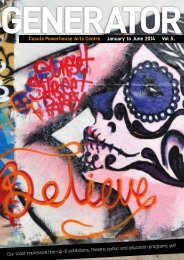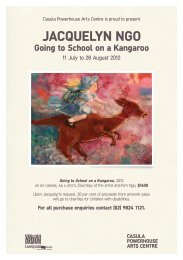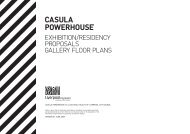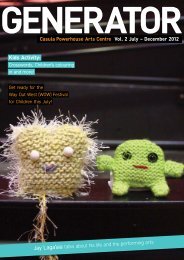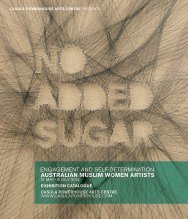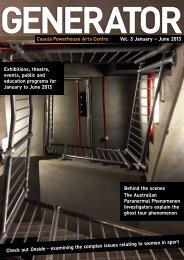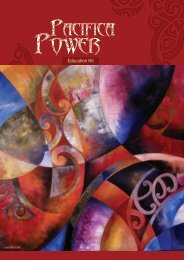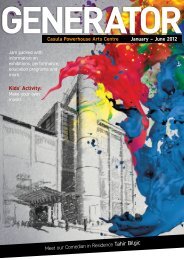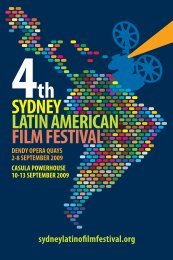Using the Education Kit - Casula Powerhouse
Using the Education Kit - Casula Powerhouse
Using the Education Kit - Casula Powerhouse
Create successful ePaper yourself
Turn your PDF publications into a flip-book with our unique Google optimized e-Paper software.
<strong>Education</strong> <strong>Kit</strong>
<strong>Using</strong> <strong>the</strong> <strong>Education</strong> <strong>Kit</strong><br />
This <strong>Education</strong> <strong>Kit</strong> investigates and develops an understanding<br />
of <strong>the</strong> <strong>the</strong>mes and concepts within Cyber Cultures:<br />
Sustained Release. Students will focus on <strong>the</strong> significance of<br />
each artist involved as well as investigate <strong>the</strong> complexities that<br />
surround <strong>the</strong> development and utilisation of new media art.<br />
The <strong>Education</strong> <strong>Kit</strong> is designed to be used in conjunction with<br />
<strong>the</strong> Cyber Cultures: Sustained Release catalogues. The<br />
images and information in <strong>the</strong> catalogues can be extracted and<br />
used with <strong>the</strong> o<strong>the</strong>r <strong>Education</strong> <strong>Kit</strong> materials and activities.<br />
The Cyber Cultures: Sustained Release website is an<br />
integral part of <strong>the</strong> <strong>Education</strong> <strong>Kit</strong>. The website includes<br />
information about <strong>the</strong> artists and <strong>the</strong>ir work as well as<br />
catalogue essays and links to many of <strong>the</strong> artists’ websites. The<br />
archive section of <strong>the</strong> website also links to earlier Cyber<br />
Cultures exhibitions and catalogue essays.<br />
www.casulapowerhouse.com/cybercultures
Introduction<br />
Cyber Cultures: Sustained Release includes four <strong>the</strong>med<br />
exhibition capsules: Infectious Agents, Posthuman Bodies, New Life<br />
and Animation Playground, featuring <strong>the</strong> work of artists who are<br />
at <strong>the</strong> leading edge of innovative developments in digital new<br />
media practice.<br />
Cyber Cultures: Sustained Release allows <strong>the</strong> viewer (or<br />
user) <strong>the</strong> opportunity to explore a range of <strong>the</strong>mes and ideas<br />
including: identity, culture, au<strong>the</strong>nticity and artistic production.<br />
The exhibitions deal with <strong>the</strong>mes of contemporary identity and<br />
experience from popular culture, games and <strong>the</strong> Internet, to<br />
genetic engineering, explorations of posthuman identity and<br />
artificial life.<br />
Cyber Cultures: Sustained Release traces <strong>the</strong> relationship<br />
between art, technology and culture and illustrates how visual<br />
conventions and modes of representation are reworked and<br />
modified within new media art practices. Virtual reality,<br />
cyberspace, multimedia and interactivity are some of <strong>the</strong> new<br />
terms that are added into <strong>the</strong> lexicon of art making and<br />
perception. The exhibition offers a portal into <strong>the</strong> emerging<br />
expressive form known as new media art.<br />
“We are entering a world where <strong>the</strong>re won’t be one but<br />
two realities: <strong>the</strong> actual and <strong>the</strong> virtual.”<br />
Paul Virilio<br />
Image detail: Posthuman Bodies, Jane<br />
Prophet, Internal Organs of a Cyborg,<br />
Installation view @ <strong>Casula</strong> <strong>Powerhouse</strong><br />
Arts Centre, 2000.
In <strong>the</strong> preceding quotation, Virilio, a cultural <strong>the</strong>orist, identifies<br />
<strong>the</strong> shift in perception that has occurred with <strong>the</strong> advent of<br />
virtual reality and digital technology. Cyber Cultures:<br />
Sustained Release alerts <strong>the</strong> audience to <strong>the</strong> dynamic shifts<br />
within Visual Arts and explores <strong>the</strong> ways in which computer<br />
technology has shaped and forged new stylistic innovations and<br />
<strong>the</strong>matic concerns.<br />
The term ‘cyber’ in it’s current usage alludes to <strong>the</strong><br />
phenomenon of experience within a virtual world. Cyberspace<br />
is a place where ‘reality and life’ are reproduced and reinvented.<br />
Cyber Cultures: Sustained Release explores <strong>the</strong> current<br />
manifestation of society’s use of technology as a system of<br />
knowledge which impacts on <strong>the</strong> physical and virtual realms.<br />
Technology suggests <strong>the</strong> development of systems employing<br />
means and methods that include personal, psychological,<br />
technological, spiritual, social, cultural and biological<br />
investigations. New technologies have become a part of our<br />
everyday existence. Through video, photographs, telephones,<br />
television and <strong>the</strong> Internet, we have become part of a global<br />
village.<br />
The artists and works in Cyber Cultures: Sustained Release<br />
take new media technologies beyond <strong>the</strong> realm of everyday<br />
experience whilst at <strong>the</strong> same time examining that experience<br />
more closely. Computer based games and entertainment play a<br />
large role in our recreational activities, especially for young<br />
people, through entire arcades devoted to experiences from onscreen<br />
games to virtual environments. The artists use or<br />
appropriate forms we are familiar with from popular culture such<br />
as games, cartoons, <strong>the</strong> World Wide Web, digital images and<br />
special effects such as those we see in films, television and<br />
advertising. By taking <strong>the</strong> technology out of <strong>the</strong> arcade, <strong>the</strong><br />
home and <strong>the</strong> work place and situating it in an art gallery, Cyber<br />
Cultures: Sustained Release changes our relationship with<br />
<strong>the</strong> technology and <strong>the</strong> questions we ask of it. Implied in this is<br />
<strong>the</strong> notion of parody, where artists copy o<strong>the</strong>r forms in order to<br />
examine <strong>the</strong>m and <strong>the</strong>ir effects on us more closely.<br />
Image detail: Infectious Agents, Linda<br />
Dement, In my Gash, 1999.
Throughout history, artists have utilised <strong>the</strong> developing<br />
technologies of <strong>the</strong>ir time. Photography can be used as a<br />
comparative example. At <strong>the</strong> outset, photography was viewed<br />
as a purely documentary form ra<strong>the</strong>r than as a potential art<br />
form. Now, more than one hundred years after its invention,<br />
and with cameras in most homes in <strong>the</strong> Western world, we are<br />
easily able to acknowledge <strong>the</strong> creative possibilities and realities<br />
of photography. A similar process has happened with film and<br />
video, and this is also <strong>the</strong> likely route to <strong>the</strong> acceptance of new<br />
media technologies: as <strong>the</strong>y fill our homes, work places and<br />
entertainment venues, so does <strong>the</strong>ir creative potential become<br />
more obvious and utilised.<br />
The more mediated <strong>the</strong> creative process (i.e. <strong>the</strong> more an artist<br />
uses machines and technology to make an artwork) <strong>the</strong> more<br />
<strong>the</strong> au<strong>the</strong>nticity and originality of <strong>the</strong> artwork is questioned.<br />
Never<strong>the</strong>less, as artists and audiences become more familiar<br />
with new media technologies in everyday life, <strong>the</strong> more<br />
acceptable <strong>the</strong>y become as potential art forms.<br />
Questions about au<strong>the</strong>nticity also arise regarding new media art<br />
which are not shared by more traditional mediums. New media<br />
technologies provide artists with <strong>the</strong> ability to make works that<br />
are both infinitely reproducible and can be modified so that<br />
different versions can be exhibited at different stages of<br />
development. The interactive nature of new media art also<br />
means that audiences can experience different versions of <strong>the</strong><br />
work depending on which pathways <strong>the</strong>y explore in <strong>the</strong><br />
interaction. All <strong>the</strong>se factors bring into question traditional<br />
artistic notions of <strong>the</strong> ‘original’ and <strong>the</strong> ‘au<strong>the</strong>ntic’.<br />
The role of <strong>the</strong> audience also takes on a special importance in<br />
interactive new media art. The audience member is<br />
transformed from viewer to participant and <strong>the</strong>ir interaction is<br />
an integral component in <strong>the</strong> structure and experience of <strong>the</strong><br />
work.<br />
While new media art is still a relatively new art form, it is set<br />
to play a key role in cultural production in <strong>the</strong> new century<br />
introducing new modes ofartistic expression and new forms of<br />
representation. Cyber Cultures: Sustained Release<br />
invites teachers and students to explore <strong>the</strong> work of some of<br />
<strong>the</strong> leading artists in this field and to assess <strong>the</strong> contibution of<br />
this new art form to Visual Arts practice.<br />
Image detail, Posthuman Bodies,<br />
Gary Zebington, Bodyssey, 2000.
General Exhibition Activities for<br />
Cyber Cultures: Sustained Release<br />
K-6<br />
1. Look at <strong>the</strong> design logo produced<br />
by Martine Corompt. Design<br />
your own logo for Cyber<br />
Cultures: Sustained Release.<br />
2. What do new technologies share<br />
with o<strong>the</strong>r media? Consider<br />
printmaking, film and<br />
photography.<br />
3. Most of <strong>the</strong> artworks in <strong>the</strong><br />
exhibition rely on interactivity<br />
with <strong>the</strong> audience, that is to say<br />
that <strong>the</strong> artwork must be<br />
touched and handled by <strong>the</strong><br />
audience. Design your own<br />
interactive artwork and explain<br />
with <strong>the</strong> aid of diagrams what<br />
your artwork does. You must<br />
include a title for your artwork.<br />
4. Select one of <strong>the</strong> artworks and<br />
give <strong>the</strong> work a new title, which<br />
you think is more appropriate.<br />
Explain why you gave it this title.<br />
5. In groups of 2 to 4, select one of<br />
<strong>the</strong> artworks and write a review<br />
of it. In your review you must<br />
write at least one sentence that:<br />
• Describes what <strong>the</strong> artwork is<br />
and how it appears.<br />
• Explains what <strong>the</strong> artwork is<br />
about.<br />
• Evaluates <strong>the</strong> artwork in terms<br />
of whe<strong>the</strong>r you think it is<br />
successful as an artwork.<br />
6. Select <strong>the</strong> artwork you think is<br />
<strong>the</strong> most exciting and list 20<br />
words that best describes <strong>the</strong><br />
work. Use <strong>the</strong>se words in<br />
sentences to construct an<br />
appraisal of <strong>the</strong> artwork.
7-10<br />
1. Most of <strong>the</strong> artworks in Cyber<br />
Cultures: Sustained Release<br />
construct installations. What is<br />
an installation? As a group<br />
exercise construct your own<br />
installation in some part of <strong>the</strong><br />
school.<br />
2. Design a poster for <strong>the</strong> Cyber<br />
Cultures: Sustained Release<br />
exhibition. This could be mixed<br />
media, drawing, or it could be<br />
done on <strong>the</strong> computer after <strong>the</strong><br />
exhibition. The important thing<br />
is that it refers to <strong>the</strong> exhibition<br />
and suggests an exciting and<br />
futuristic show.<br />
3. Create your own interactive<br />
artwork on <strong>the</strong> Intranet at<br />
school or <strong>the</strong> Internet at home.<br />
Consider aspects such as: <strong>the</strong><br />
audience, <strong>the</strong>me, <strong>the</strong><br />
development of a style or look<br />
to <strong>the</strong> artwork, and its overall<br />
presentation. If you haven’t<br />
access to a computer, draw up a<br />
‘story board’ that shows<br />
individual web pages and <strong>the</strong><br />
way <strong>the</strong>se pages are linked.<br />
4. Some artists’ work in <strong>the</strong><br />
exhibition deals with important<br />
social issues. Select such an<br />
artwork and tell us what issue<br />
you think <strong>the</strong> artist is dealing<br />
with and evaluate <strong>the</strong> success of<br />
<strong>the</strong> artist’s work in terms of <strong>the</strong><br />
issues being addressed.<br />
5. In your own words describe what<br />
<strong>the</strong> word ‘cyberculture’ means.<br />
6. Divide <strong>the</strong> class into two groups<br />
and develop a debate on <strong>the</strong><br />
following topic:<br />
“Painting and photography<br />
are dead. Only ‘computers’<br />
can make new art.”<br />
7. Select one artwork and write a<br />
critical review. In your review<br />
you must:<br />
• Analyse <strong>the</strong> artwork in terms<br />
of what it does and how it is<br />
similar to or different from<br />
o<strong>the</strong>r artworks you have<br />
studied.<br />
• Interpret <strong>the</strong> meaning of <strong>the</strong><br />
work. Discuss how <strong>the</strong><br />
artworks can have different<br />
meanings for different people.<br />
• Judge whe<strong>the</strong>r you think <strong>the</strong><br />
artwork is effective and has<br />
captured your interest.<br />
11-12<br />
1. Digital art provides for new<br />
possibilities within visual arts.<br />
The artwork can be interactive,<br />
continually changing in<br />
appearance, and non-linear in<br />
presentation. Examine one or<br />
all of <strong>the</strong> artworks and consider<br />
<strong>the</strong> following:<br />
• Method of construction<br />
(program, software and<br />
hardware)<br />
• Mode of presentation<br />
(is it private or public?)<br />
• Visual conventions<br />
(is it static, dynamic and/or<br />
interactive?)<br />
2. Research artists such as Marcel<br />
Duchamp, Nam Jun Paik, Jeff<br />
Koons, Barbara Kruger and<br />
Jenny Holzer. How is, or were,<br />
<strong>the</strong> technologies used by <strong>the</strong>se<br />
artists accepted and judged?
3. Art is always in a state of<br />
constant evolution; technology,<br />
beliefs and ideology shape <strong>the</strong><br />
way that artists think and<br />
determine what media are used<br />
and how <strong>the</strong> image/object may<br />
appear. Art, like fashion,<br />
changes with <strong>the</strong> times. What<br />
do you think digital art in <strong>the</strong><br />
21 st century will offer to <strong>the</strong><br />
audience? How will this differ<br />
to what is offered in painting,<br />
photography, sculpture,<br />
drawing and architecture.<br />
5. Two essential criteria in assessing<br />
artworks are:<br />
• Technical proficiency, which<br />
refers to way <strong>the</strong> artwork has<br />
been constructed and <strong>the</strong><br />
appropriateness of <strong>the</strong><br />
materials used to convey<br />
meaning to <strong>the</strong> audience.<br />
• Conceptual strength and<br />
meaning, this relates to <strong>the</strong><br />
clarity of meaning and <strong>the</strong><br />
development of ideas<br />
communicated by <strong>the</strong> artwork.<br />
Select one artwork and<br />
investigate its technical<br />
proficiency and conceptual<br />
strength and meaning. Make a<br />
list of <strong>the</strong> artwork’s<br />
characteristics in <strong>the</strong> table<br />
below.<br />
4. Cyber Cultures: Sustained<br />
Release demonstrates <strong>the</strong><br />
constant process of<br />
technological evolution and<br />
stylistic renovation within visual<br />
arts. Discuss <strong>the</strong> impact of<br />
digital technology and<br />
postmodern <strong>the</strong>ories on<br />
contemporary art practice. Use<br />
artists from <strong>the</strong> exhibition to<br />
support your ideas.<br />
Name of Artwork: ______________________________________<br />
Technical proficiency<br />
Conceptual Strength and<br />
Meaning
Acknowledgements<br />
Curator - Kathy Cleland<br />
<strong>Education</strong> Consultant - Craig Malyon<br />
Editors - Kathy Cleland, Lisa Havilah & Sarah Vyden<br />
<strong>Education</strong> Manager - Sarah Vyden<br />
Graphic Design - Milk Bar Studios<br />
Published by <strong>the</strong> <strong>Casula</strong> <strong>Powerhouse</strong> Arts Centre<br />
ISBN 1 876418 17 6<br />
© 2001 Authors, Artists & <strong>Casula</strong> <strong>Powerhouse</strong> Arts Centre.<br />
No material whe<strong>the</strong>r written or photographic, may be<br />
reproduced without <strong>the</strong> permission of <strong>the</strong> artists,<br />
authors and <strong>Casula</strong> <strong>Powerhouse</strong> Arts Centre.<br />
To place catalogue and education kit orders please<br />
contact <strong>Casula</strong> <strong>Powerhouse</strong> Arts Centre.<br />
<strong>Casula</strong> <strong>Powerhouse</strong> Arts Centre<br />
PO Box 190<br />
<strong>Casula</strong>, NSW, Australia 2170<br />
Tel. 61 2 9824 1121 Fax. 61 2 9821 4273<br />
Email: admin@casulapowerhouse.com<br />
www.casulapowerhouse.com/cybercultures<br />
Cyber Cultures: Sustained Release is developed<br />
Image detail: Posthuman Bodies, Jane Prophet, Internal Organs of a<br />
Cyborg, Installation view @ <strong>Casula</strong> <strong>Powerhouse</strong> Arts Centre, 2000.<br />
and toured by <strong>Casula</strong> <strong>Powerhouse</strong> Arts Centre.<br />
The tour of this exhibition is made possible by<br />
AUSTRALIAN<br />
FILM<br />
COMMISSION



